1. General Definition:
If to every value (Considered as real unless other−wise stated) of a variable x, which belongs to some collection (Set) E, there corresponds one and only one finite value of the quantity y, then y is said to be a function (Single valued) of x or a dependent variable defined on the set E ; x is the argument or independent variable .
If to every value of x belonging to some set E there corresponds one or several values of the variable y, then y is called a multiple valued function of x defined on E.Conventionally the word "Function” is used only as the meaning of a single valued function, if not otherwise stated. Pictorially: 
 , y is called the image of x & x is the pre-image of y under f. Every function from A → B satisfies the following conditions .
, y is called the image of x & x is the pre-image of y under f. Every function from A → B satisfies the following conditions .
(i) f ⊂ A x B (ii) ∀ a ∈ A ⇒ (a, f(a)) ∈ f and (iii)(a, b) ∈ f & (a, c) ∈ f ⇒ b = c
2. Domain, CO−−−−Domain & Range Of A Function:
Let f : A → B, then the set A is known as the domain of f & the set B is known as co-domain off . The set of all f images of elements of A is known as the range off . Thus
Domain of f = {a| a ∈ A, (a, f(a)) ∈ f}
Range of f = {f(a) |a ∈ A, f(a) ∈ B}
It should be noted that range is a subset of co−domain . If only the rule of function is given then the domain of the function is the set of those real numbers, where function is defined. For a continuous function, the interval from minimum to maximum value of a function gives the range.
3. Important Types of Functions :
(i) Polynomial Function : If a function f is defined by f (x) = a0 xn + a1 xn−1 + a2 xn−2 + ... + an−1 x + an where n is a non negative integer and a0, a1, a2, ..., an are real numbers and a0 ≠ 0, then f is called a polynomial function of degree n NOTE : (a) A polynomial of degree one with no constant term is called an odd linear function . i.e. f(x) = ax , a ≠ 0.
(b) There are two polynomial functions , satisfying the relation ; f(x).f(1/x) = f(x) + f(1/x). They are :
(i) f(x) = xn + 1 & (ii) f(x) = 1 − xn , where n is a positive integer .
(ii) Algebraic Function : y is an algebraic function of x, if it is a function that satisfies an algebraic equation of the form P0 (x) yn + P1 (x) yn−1 + ....... + Pn−1 (x) y + Pn (x) = 0 Where n is a positive integer and P0 (x), P1 (x) ........... are Polynomials in x.
e.g. y = |x| is an algebraic function, since it satisfies the equation y² − x² = 0.
Note that all polynomial functions are Algebraic but not the converse. A function that is not algebraic is called Transcedental Function.
(iii) Fractional Rational Function: A rational function is a function of the form. y = f (x) =  where g (x) & h (x) are polynomials & h (x) ≠ 0.
where g (x) & h (x) are polynomials & h (x) ≠ 0.
(iv) Absolute Value Function: A function y = f (x) = |x| is called the absolute value function or Modulus function. It is defined as : 
(V) Exponential Function : A function f(x) = ax = ex ln a (a > 0 ,a ≠ 1, x ∈ R) is called an exponential function. The inverse of the exponential function is called the logarithmic function . i.e. g(x) = loga x .
Note that f(x) & g(x) are inverse of each other & their graphs are as shown .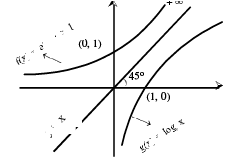
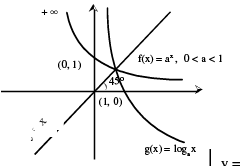
(vi) Signum Function : A function y= f (x) = Sgn (x) is defined as follows :
It is also written as Sgn x = |x|/ x ; x ≠ 0 ; f (0) = 0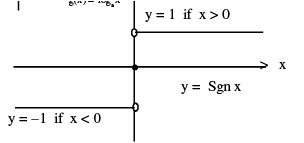
(vii) Greatest Integer or Step Up Function : The function y = f (x) = [x] is called the greatest integer function where [x] denotes the greatest integer less than or equal to x . Note that for :
Properties of greatest integer function :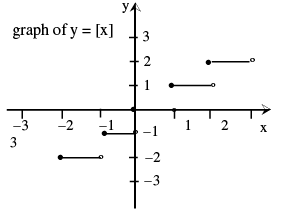
(a) [x] ≤ x < [x] + 1 and
x − 1 < [x] ≤ x , 0 ≤ x − [x] < 1
(b) [x + m] = [x] + m if m is an integer .
(c) [x] + [y] ≤ [x + y] ≤ [x] + [y] + 1
(d) [x] + [− x] = 0 if x is an integer = − 1 otherwise .
(viii) Fractional Part Function : It is defined as : g (x) = {x} = x − [x] . e.g. the fractional part of the no. 2.1 is 2.1− 2 = 0.1 and the fractional part of − 3.7 is 0.3. The period of this function is 1 and graph of thi s function is as shown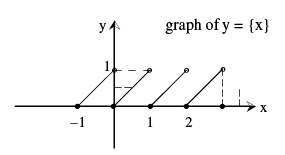
4. Domains And Ranges of Common Function :
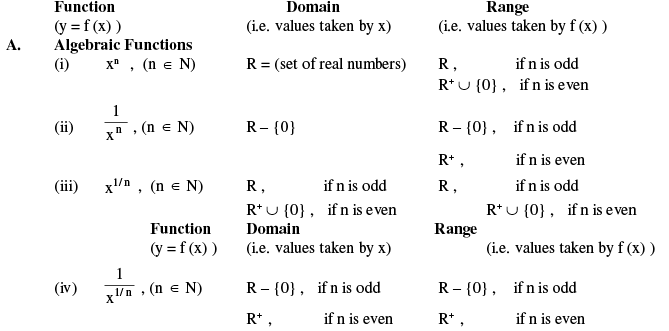


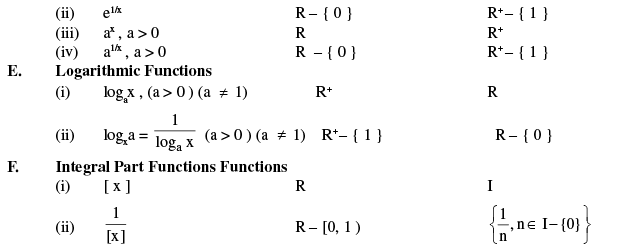
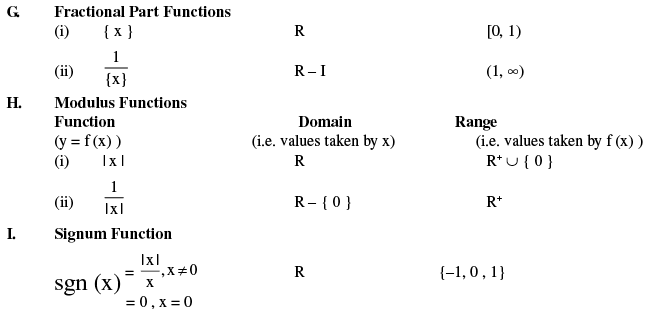

J. Constant Function
say f (x) = c R { c }
5. Equal Or Identical Function :
Two functions f & g are said to be equal if :
(i) The domain of f = the domain of g.
(ii) The range of f = the range of g and
(iii) f(x) = g(x) , for every x belonging to their common domain. eg.
6. Classification of Functions : One −−−− One Function (Injective mapping) : A function f : A → B is said to be a one−one function or injective mapping if different elements of A have different f images in B . Thus for x1, x2 ∈ A & f(x1) , f(x2) ∈ B , f(x1) = f(x2) ⇔ x1 = x2 or x1 ≠ x2 ⇔ f(x1) ≠ f(x2) .
Diagramatically an injective mapping can be shown as

Note :
(i) Any function which is entirely increasing or decreasing in whole domain, then f(x) is one−one .
(ii) If any line parallel to x−axis cuts the graph of the function at most at one point, then the function is one−one .
Many–one function : A function f : A → B is said to be a many one function if two or more elements of A have the same f image in B . Thus f : A → B is many one if for ; x1, x2 ∈ A , f(x1) = f(x2) but x1 ≠ x2
Diagramatically a many one mapping can be shown as

Note :
(i) Any continuous function which has at least one local maximum or local minimum, t h e n f( x ) is many−one . In other words, if a line parallel to x−axis cuts the graph of the function at least at two points, then f is many−one .,
(ii) If a function is one−one, it cannot be many−one and vice versa .
Onto function (Surjective mapping) : If the function f : A → B is such that each element in B (co−domain) is the f image of at least one element in A, then we say that f is a function of A 'onto' B . Thus f : A → B is surjective if f ∀ b ∈ B, ∃ some a ∈ A such that f (a) = b .
Diagramatically surjective mapping can be shown as

Note that : if range = co−domain, then f(x) is onto. Into function : If f : A → B is such that there exists at least one element in co−domain which is not the image of any element in domain, then f(x) is into .
Diagramatically into function can be shown as

Note that : If a function is onto, it cannot be into and vice versa . A polynomial of degree even will always be into. Thus a function can be one of these four types :
(a) one−one onto (injective & surjective) 
(b) one−one into (injective but not surjective) 
(c) many−one onto (surjective but not injective) 
(d) many−one into (neither surjective nor injective) 
Note :
(i) If f is both injective & surjective, then it is called a Bijective mapping.
The bijective functions are also named as invertible, non singular or bi uniform functions.
(ii) If a set A contains n distinct elements then the number of different functions defined from A → A is nn & out of it n ! are one one.
Identity function : The function f : A → A defined by f(x) = x ∀ x ∈ A is called the identity of A and is denoted by IA. It is easy to observe that identity function is a bijection .
Constant function: A function f : A → B is said to be a constant function if every element of A has the same f image in B . Thus f : A → B ; f(x) = c , ∀ x ∈ A , c ∈ B is a constant function. Note that the range of a constant function is a singleton and a constant function may be one-one or many-one, onto or into .
7. Algebraic Operations on Functions :
If f & g are real valued functions of x with domain set A, B respectively, then both f & g are defined in A ∩ B. Now we define f + g , f − g , (f . g) & (f/g) as follows :
(i) (f ± g) (x) = f(x) ± g(x) 
(ii) (f . g) (x) = f(x) . g(x)
(iii)
 domain is {x | x ∈ A ∩ B s . t g(x) ≠ 0} .
domain is {x | x ∈ A ∩ B s . t g(x) ≠ 0} .
8. Composite Of Uniformly & Non - Uniformly Defined Functions:
Let f : A → B & g : B → C be two functions . Then the function gof : A → C defined by (gof) (x) = g (f(x)) ∀ x ∈ A is called the composite of the two functions f & g .
Diagramatically 
Thus the image of every x ∈ A under the function gof is the g−image of the f−image of x .Note that g of is defined only if ∀ x ∈ A, f(x) is an element of the domain of g so that we can take its g-image. Hence for the product gof of two functions f & g, the range of f must be a subset of the domain of g.
Properties of Composite Functions:
(i) The composite of functions is not commutative i.e. gof ≠ fog .
(ii) The composite of functions is associative i.e. if f, g, h are three functions such that fo (goh) & (fog) oh are defined, then fo (goh) = (fog) oh .
(iii) The composite of two bijections is a bijection i.e. if f & g are two bijections such that gof is defined, then gof is also a bijection.
9. Homogeneous Functions:
A function is said to be homogeneous with respect to any set of variables when each of its terms is of the same degree with respect to those variables .
For example 5 x2 + 3y2 − xy is homogeneous in x & y . Symbolically if , f (tx , ty) = tn . f (x , y) then f (x , y) is homogeneous function of degree n .
10. Bounded Function:
A function is said to be bounded if |f(x)| ≤ M , where M is a finite quantity .
11. Implicit & Explicit Function:
A function defined by an equation not solved for the dependent variable is called an Implicit Function . For eg. the equation x3 + y3 = 1 defines y as an implicit function. If y has been expressed in terms of x alone then it is called an Explicit Function.
12. Inverse Of a Function : Let f : A → B be a one−one & onto function, then their exists a unique function g : B → A such that f(x) = y ⇔ g(y) = x, ∀ x ∈ A & y ∈ B . Then g is said to be inverse of f . Thus g = f−1 : B → A = {(f(x), x) | (x, f(x)) ∈ f} .
Properties of Inverse Function :
(i) The inverse of a bijection is unique .
(ii) If f : A → B is a bijection & g : B → A is the inverse of f, then fog = IB and gof = IA , where IA & IB are identity functions on the sets A & B respectively.
Note that the graphs of f & g are the mirror images of each other in the line y = x . As shown in the figure given below a point (x ',y ' ) corresponding to y = x2 (x >0) changes to (y ',x ' ) corresponding to y = + x , the changed form of x =√ y .
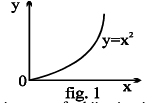
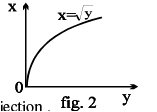
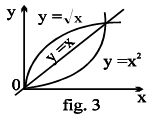
(iii) The inverse of a bijection is also a bijection .
(iv) If f & g two bijections f : A → B , g : B → C then the inverse of gof exists and (gof)−1 = f−1o g−1 13.
Odd & Even Functions : If f (−x) = f (x) for all x in the domain of ‘f’ then f is said to be an even function. e.g. f (x) = cos x ; g (x) = x² + 3 . If f (−x) = −f (x) for all x in the domain of ‘f’ then f is said to be an odd function. e.g. f (x) = sin x ; g (x) = x3 + x .
NOTE :
(a) f (x) − f (−x) = 0 ⇒ f (x) is even & f (x) + f (−x) = 0 ⇒ f (x) is odd .
(b) A function may neither be odd nor even .
(c)Inverse of an even function is not defined
(d) Every even function is symmetric about the y−axis & every odd function is symmetric about the origin.
(e) Every function can be expressed as the sum of an even & an odd function.

(f) only function which is defined on the entire number line & is even and odd at the same time is f(x)= 0. (g) If f and g both are even or both are odd then the function f.g will be even but if any one of them is odd then f.g will be odd .
14. Periodic Function : A function f(x) is called periodic if there exists a positive number T (T > 0) called the period of the function such that f (x + T) = f(x), for all values of x within the domain of x e.g. The function sin x & cos x both are periodic over 2π & tan x is periodic over π
NOTE:
(a) f (T) = f (0) = f (−T) , where ‘T’ is the period .
(b) Inverse of a periodic function does not exist .
(c) Every constant function is always periodic, with no fundamental period.
(d) If f (x) has a period T & g (x) also has a period T then it does not mean that f (x) + g (x) must have a period T . e.g. f(x) = |sinx| + |cosx|.
(e) If f(x) has a period p, then  also has a period p.
also has a period p.
(f) if f(x) has a period T then f(ax + b) has a period T/a (a > 0) .
15. General: If x, y are independent variables, then :
(i) f(xy) = f(x) + f(y) ⇒ f(x) = k ln x or f(x) = 0 .
(ii) f(xy) = f(x) . f(y) ⇒ f(x) = xn , n ∈ R
(iii) f(x + y) = f(x) . f(y) ⇒ f(x) = akx .
(iv) f(x + y) = f(x) + f(y) ⇒ f(x) = kx, where k is a constant .













